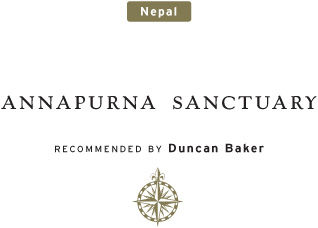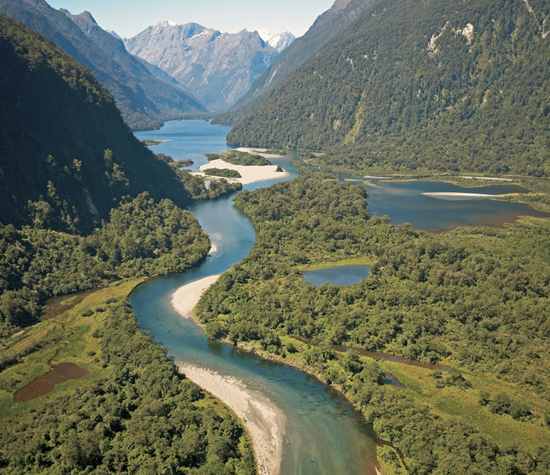
“I first went to Nepal in 1979,” Duncan Baker began, “as I was serving in the British Army, and was dispatched to work with the Gurkhas [a brigade of Nepalese soldiers who have fought for Great Britain since the early 1800s]. I found myself trekking all over the Annapurnas and western Nepal, as the men we recruited came from that region. My long treks piqued my interest in the country and its people. After my stint in the army was finished, I eventually made my way back to the Annapurnas with a view to starting a trekking company that could employ some of my retired Gurkha comrades.”
“Trekking” and “Nepal”—the two words go together like “bread and butter” or “Lennon and McCartney.” With a northern border that straddles the Himalaya Mountains for its entire length, Nepal has long had the terrain to titillate and astound walkers. The conceptual framework for making Nepal a trekking center can be traced to Colonel Jimmy Roberts, a former Gurkha officer and military attaché at the British Embassy in Kathmandu. Well familiar with Nepal’s mountains and valleys, Colonel Roberts had the notion to provide visitors with tents and local guides—Sherpas—to lead them through the countryside and prepare meals. (While the term “Sherpa” has come to mean mountain guide or porter for many, Sherpas are actually an ethnic group from Tibet who have lived in Nepal for more than 300 years.) This was in 1965. The next year, less than a hundred trekker-tourists visited Nepal. In 2002, it was estimated that some 70,000 visitors engaged in some level of Nepalese hiking. The treks are broken into two broad categories: full trekking, where you (and your porters) carry your gear and make and break a tent camp each night, as on a backpacking trip; and teahouse trekking, where you stay in a lodge as you follow the route, rather like hut hiking in the Alps or New Zealand.
The first trek that comes to mind for many would-be Nepal trekkers is the expedition to the base camp at Everest—after all, who hasn’t thought about at least getting close to the world’s tallest mountain? “When people come to us with an interest in hiking to Everest Base Camp, we’re happy to oblige them,” Duncan continued. “But we try to be clear about what’s involved. It’s a considerable time commitment, and the altitudes encountered on that walk (more than 18,000 feet) make some people think twice. I like to present Annapurna as a great alternative. You can get into the mountains easily, starting at altitudes of 3,000 feet. You have a host of incredible mountains right in front of you. You can go as high as you wish—up to 13,550 feet. And on a trek like the Annapurna Sanctuary, can get a great taste of the Nepalese hiking experience, whether you’re only able to spare two days for a trek or have two weeks.”
The Annapurna Sanctuary is a high glacial basin that rests between the city of Pokhara to the south and the mountains to the north. “It’s not called a ‘sanctuary’ because of laws that protect wildlife within its boundaries,” Duncan explained, “but because of its natural serenity, beauty, and the local belief of the divine presence of the Hindu goddesses Annapurna and Gangapurna. Sitting in Sanctuary Meadows at 13,200 feet, surrounded by a 360-degree panorama of incredible Himalayan peaks—Hiunchuli, Annapurna South, Fang, Annapurna II, Roc Noir, Glacier Dome, Gangapurna, Annapurna III, and Machhapuchhre—towering nearly two miles above you, is a sublime experience. And it can only be reached on one trail.”
The Annapurna Sanctuary trek begins in Lumle, an hour north of Pokhara. At the outset, you’re at a modest elevation of 3,000 feet, in the shadow of Machhapuchhre (22,943 feet), sometimes called Fish Tail Mountain, an abrupt spire that’s been likened to the Matterhorn. Over the next six days, you gradually gain altitude as you make your way toward Panchenin Barha, a narrow point in the canyon that serves as a natural “gate” to the sanctuary; Annapurna Base Camp lies just a few miles ahead. “One of the aspects I like about this trek is that it takes you through a host of climatic zones—subtropical, temperate, and alpine,” Duncan said. “You also pass through a number of mountain villages where the people have been doing subsistence farming for hundreds of years—growing rice in the lower elevations, corn and potatoes at higher altitudes. If you push along hard, you can make it into the base camp and out in seven days, but I like to take a few extra days so I can linger in the villages and get a sense of life there; our notion has always been that you’ll see the mountains, yes, but you’ll also experience village life. There are four lodges that we built along the trekking route in the 1990s that guests stay at, and several teahouses that we frequent. The idea is that you walk four or five hours each day, arrive in time for a late lunch and plenty of time to explore the villages, then have a warm shower and a soft bed.”
Cultural lessons aside, the sights along the Sanctuary trail are an intoxicating attraction. On the alpine sections of the trail there are vast forests of rhododendron, and in spring bloom they paint the valleys in a riot of color, abetted by magnolia and accented with ferns and orchids. Nearly 500 birds have been identified, among them resident satyr tragopan and cheer pheasant, both threatened species. For Duncan, it’s hard to beat early mornings along the trail. “Every morning, I like to be up at sunrise with a mug of hot coffee or tea. On the first few days of the trek, it’s not very cold as you’re not at altitude. I love to watch the local people making their way to their fields, so calm and peaceful. It’s almost always clear in the early morning, and you feel the sun as it lights up the enormous mountains.”
DUNCAN BAKER served as an officer in the British army with the Gurkhas, which first took him to Nepal in 1979. After leaving the army, he returned to Nepal to start a trekking company with some of his former comrades, and eventually built a number of small, comfortable lodges in the Annapurnas. He is a director of Ker & Downey Nepal and spends much of the year in Nepal.

► Getting There: International travelers will fly into Kathmandu, Nepal, which is served by a number of carriers, including Thai Airways (800-426-5204; www.thaiair.com). From here, it’s a brief flight to Pokhara, which is served by a number of domestic carriers, including Buddha Air (+ 977 1 5542494; www.buddhaair.com).
► Best Time to Visit: October and November are the most popular months to visit, as the weather is generally clear. Early spring—March and April—can also have clearer weather, as well as great rhododendron displays.
► Guides/Outfitters: Many companies sell and lead trips to Annapurna, including Ker & Downey (+977-61-523-701; www.trekking-nepal.com).

Sandfly Point marks the end of the Milford Track. From here, it’s a short boat ride to Milford Sound.